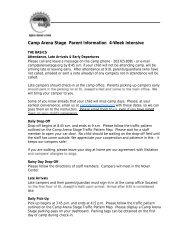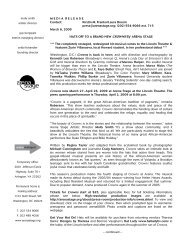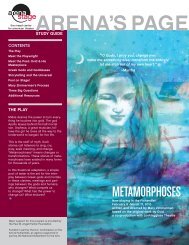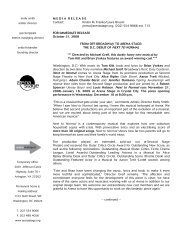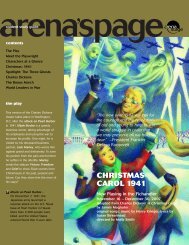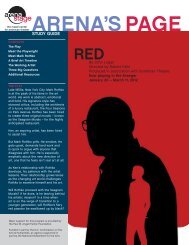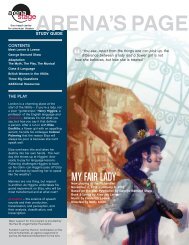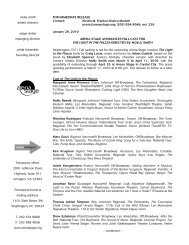OKLaHOMa! - Arena Stage
OKLaHOMa! - Arena Stage
OKLaHOMa! - Arena Stage
You also want an ePaper? Increase the reach of your titles
YUMPU automatically turns print PDFs into web optimized ePapers that Google loves.
Meet the Creators:<br />
Richard Rodgers (music)<br />
and<br />
Oscar Hammerstein II<br />
(book & lyrics)<br />
“Not only is Oklahoma! the most important of the Rodgers and<br />
Hammerstein musicals, it is also the single most influential work in<br />
the American musical theater.”– Thomas Hischak, playwright and theater writer<br />
A New Type of Musical<br />
Before Oklahoma!, most musicals were a series of jokes strung together to showcase<br />
the main attraction: the songs or, in some cases, the star. Oklahoma! marks a major<br />
change in musical form.<br />
It is the first musical of its kind: a book musical. Each song and dance is part of a<br />
story that has a beginning, middle and end. It also demonstrates the emotional depths<br />
of its characters and deals with serious social issues, like land disputes and violence.<br />
Whenever I get an idea for a song,<br />
even before jotting down the notes,<br />
I can hear it in the orchestra; I can<br />
smell it in the scenery; I can see<br />
the kind of actor who will sing it;<br />
and I am aware of an audience<br />
listening to it.”<br />
— Richard Rodgers<br />
Better known as simply<br />
Rodgers & Hammerstein: the<br />
creators of Oklahoma! are<br />
the most famous partnership in<br />
American musical theater.<br />
Before they were Rodgers &<br />
Hammerstein, Richard Rodgers<br />
began playing the piano at age 6.<br />
During his early teenage years, he<br />
attended a summer camp where he<br />
composed some of his first songs.<br />
Meanwhile, Oscar Hammerstein’s<br />
father disapproved of his<br />
son’s desire to pursue theater.<br />
Nonetheless, Hammerstein dropped<br />
out of law school to do so.<br />
Both men grew up in New York City<br />
and attended the same college,<br />
although they didn’t know each<br />
other at the time. After meeting<br />
in 1943, they went on to have a<br />
fruitful partnership because their<br />
working styles fit together well:<br />
Hammerstein preferred to write<br />
a complete lyric (words) before<br />
it was set to music, and Rodgers<br />
preferred to set completed lyrics to<br />
music.<br />
Together, Rodgers and<br />
Hammerstein created awardwinning,<br />
beloved musicals like<br />
Carousel; South Pacific; The King<br />
and I and The Sound of Music. l<br />
Oklahoma! features another element new to musicals: the dream ballet. A dance number<br />
showcasing major themes of the story, the dream ballet does not contain any<br />
singing or speaking. The dream sequence is significant because it brought dance to a<br />
nearly equal level of importance as text and song. l<br />
Box Socials<br />
“Wake up, Laurey. It’s time to start fer the party.”<br />
— Jud Fry, Oklahoma!<br />
A box social was a dance or<br />
fundraiser for an organization, like a<br />
school or church. Women decorated<br />
cardboard boxes or lunch hampers<br />
that held enough food for two<br />
people. At the dance, men would bid<br />
against one another for the box of<br />
their choice. The prize for the highest<br />
bidder Sharing the meal in the box<br />
with the woman who made it. l<br />
Farmers and Cowmen<br />
What is a surrey<br />
A surrey is a horsedrawn<br />
carriage<br />
typically ridden for<br />
pleasure and not<br />
for traveling long<br />
distances. What<br />
would owning a<br />
surrey symbolize for<br />
a farmer or cowboy in<br />
Oklahoma<br />
Most settlers that arrived after the land runs in the late 1800s farmed, growing<br />
crops to make a living or provide food for their families. At the same time<br />
ranchers and cowboys had cattle that grazed freely on the open range<br />
(government-owned land), sometimes eating farmers’ crops or trampling young plants.<br />
These conflicting livelihoods led to competition for land and clashes between farmers<br />
and ranchers. l<br />
The invention of barbed wire escalated rancher-farmer relationships. It separated one<br />
person’s land from another and established property lines that, if crossed by a trespasser,<br />
could be punishable by law. Some ranchers who grazed their cattle on the open range started<br />
cutting fences to be able to drive their cattle between tracts of state land and to water.<br />
ACTIVITY: Look through headlines in a recent newspaper to find some articles<br />
about territory laws or conflicts. What strategy would you use to negotiate<br />
between the opposing groups How are these issues like or unlike the<br />
disagreements between the ranchers and farmers



